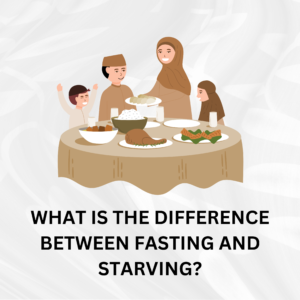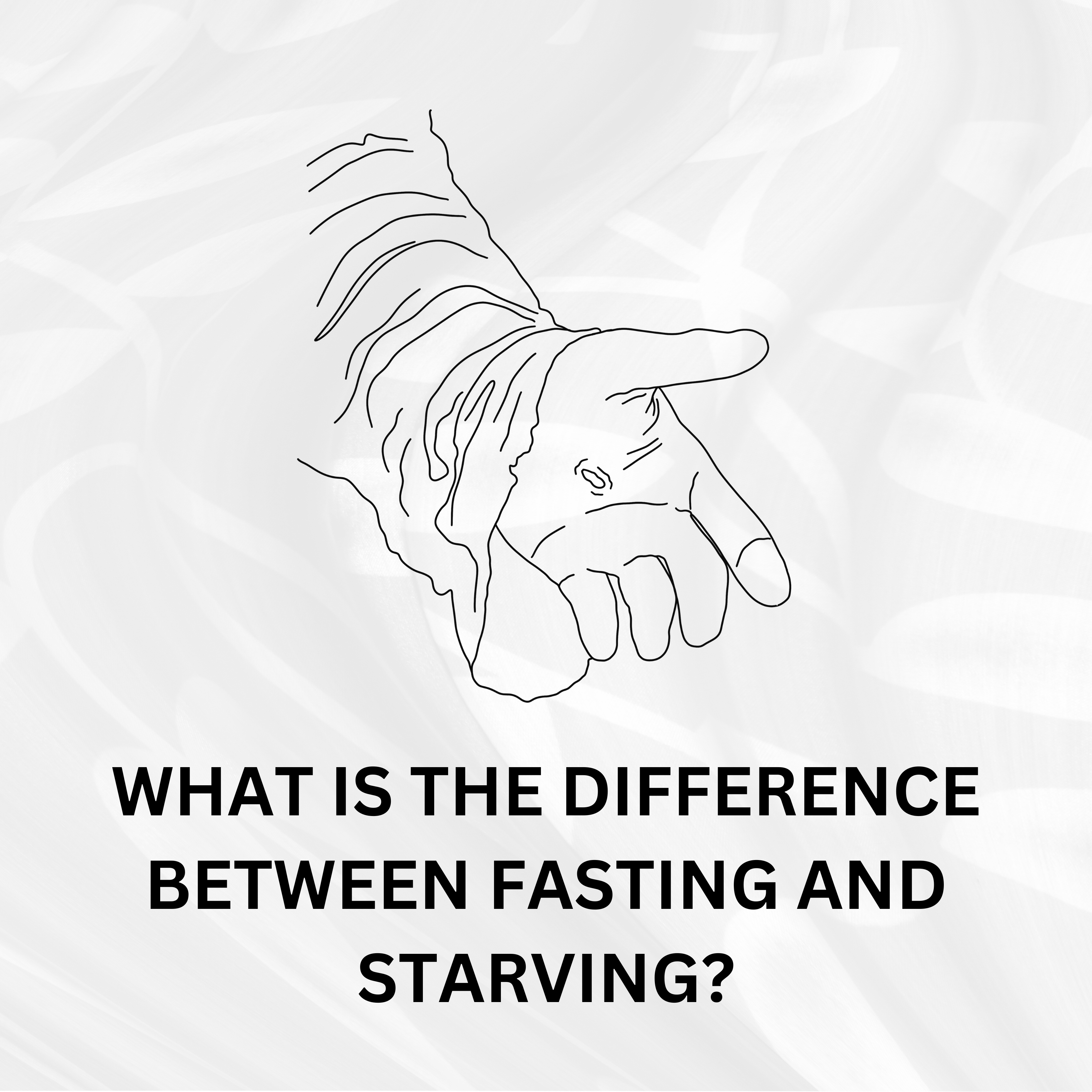Introduction: What is the Difference Between Fasting and Starving?
Fasting and starving are two terms often used interchangeably, but they represent very different experiences, both in terms of biology, health, and intent. While both involve periods of food deprivation, fasting is a voluntary act often undertaken for religious, spiritual, health, or detox purposes, whereas starving is an involuntary state that occurs when a person does not have access to enough food to meet their body’s basic energy and nutritional needs. In this article, we will explore the significant differences between fasting and starving, the physiological effects of both, their impacts on health, and how each is perceived in society.
What is Fasting?

Fasting is the voluntary and controlled abstention from food or drink for a specified period of time. People fast for a variety of reasons, including:
- Religious and Spiritual Reasons: Many religions, including Islam, Christianity, Judaism, and Buddhism, incorporate fasting as part of spiritual practice, believing it helps cleanse the soul, focus the mind, and strengthen spiritual discipline.
- Health and Medical Reasons: Intermittent fasting, for instance, has gained popularity as a potential method for weight loss, improved metabolic health, and longevity. Some medical fasting is also conducted under supervision to treat conditions like obesity or type 2 diabetes.
- Detoxification: Some people fast to detoxify the body, believing that giving the digestive system a break helps flush out toxins.
Fasting typically occurs in specific intervals—ranging from hours to days—and it is done with the understanding that the body is getting the nutrients it needs in the long term. During a fast, it’s common to consume liquids, such as water or herbal teas, but solid food is usually avoided.
Types of Fasting
There are several types of fasting, each with its own set of rules and benefits:
- Intermittent Fasting (IF): This approach cycles between periods of eating and fasting. One of the most common patterns is the 16/8 method, where a person fasts for 16 hours and eats during an 8-hour window.
- Water Fasting: Involves abstaining from all food and drink except water.
- Juice Fasting: Involves consuming only fruit and vegetable juices.
- Prolonged Fasting: Involves fasting for more than 24 hours and may last for several days or even weeks under medical supervision.
Health Benefits of Fasting
Fasting has been studied extensively, and many health experts suggest that it can offer a range of benefits:
- Improved Insulin Sensitivity: Fasting can help lower blood sugar levels and improve insulin sensitivity, which is beneficial for managing or preventing type 2 diabetes.
- Weight Loss: Fasting can be an effective way to reduce calorie intake and promote weight loss.
- Cellular Repair and Longevity: Some studies suggest that fasting can trigger autophagy, a process where the body cleans out damaged cells, which may improve longevity.
- Reduced Inflammation: Some research has indicated that fasting may help reduce markers of inflammation, which is linked to various chronic diseases.
While fasting can have significant health benefits, it should be done cautiously and ideally under medical supervision, particularly if extended periods of fasting are involved.
What is Starving?
Starvation, on the other hand, is an involuntary and extreme state of food deprivation caused by a lack of access to food. It typically occurs in situations of food scarcity, poverty, or severe malnutrition, where the body is unable to obtain sufficient nutrients to maintain normal physiological functions.
Starving is not just the absence of food; it is the result of the body’s inability to acquire or absorb enough nutrients (calories, proteins, fats, vitamins, and minerals) over an extended period. If not addressed, starvation can have serious consequences, leading to permanent organ damage, muscle wasting, and ultimately death.
The Physiological Process of Starvation
During starvation, the body goes through several stages to conserve energy and survive:
- Initial Phase (Fasting Response): In the early stages of starvation, the body taps into its glycogen stores (stored carbohydrates in the liver and muscles) to maintain blood glucose levels.
- Ketosis Phase: Once glycogen stores are depleted (usually after 24–48 hours), the body begins to break down fat for energy, converting fatty acids into ketones, which can be used by the brain and other tissues as an alternative fuel source.
- Protein Catabolism: After prolonged periods without food, the body starts breaking down muscle tissue to obtain amino acids for essential functions like the production of enzymes and hormones. This phase accelerates as starvation continues.
- Organ Failure: Eventually, if starvation continues for weeks or months, the body will begin to shut down non-essential systems. Organ failure, including liver and kidney failure, becomes imminent as the body’s resources are completely exhausted.
Symptoms of Starvation
The signs of starvation are severe and progressive:
- Severe Fatigue and Weakness: As the body lacks energy, physical and mental performance decline.
- Weight Loss: Significant muscle and fat loss, leading to extreme emaciation.
- Hair Loss: Lack of protein and nutrients can cause hair to thin and fall out.
- Edema: Swelling in the legs, feet, or abdomen due to imbalances in electrolytes and protein.
- Impaired Immune Function: Without adequate nutrition, the immune system weakens, making the body more vulnerable to infections.
- Psychological Effects: Anxiety, depression, irritability, and confusion often accompany severe starvation.
Causes of Starvation
Starvation is typically caused by factors beyond an individual’s control:
- Famine: Natural disasters, crop failures, and other environmental factors that result in a shortage of food.
- Economic Hardship: Poverty and the inability to afford or access food.
- War and Conflict: Areas affected by conflict may experience food blockages, destruction of food supplies, and displacement, all of which contribute to starvation.
- Medical Conditions: Certain medical conditions, such as cancer or gastrointestinal diseases, may prevent individuals from absorbing nutrients, leading to malnutrition and starvation.
Key Differences Between Fasting and Starving
While both fasting and starving involve the cessation of food intake, the crucial difference lies in the intent, duration, and impact on health. Below, we outline the primary distinctions:
Intent and Control
- Fasting: A voluntary act, usually undertaken for a specific reason (religious, health, or spiritual). The individual has control over the timing, duration, and type of fast.
- Starving: An involuntary condition where the body is deprived of food due to external factors like food scarcity, illness, or poverty. The individual has no control over the lack of food and typically experiences physical distress as a result.
Duration
- Fasting: Lasts for a specific period, usually ranging from a few hours to several days, with planned breaks to restore the body’s nutrition.
- Starving: This lasts until the individual receives adequate nutrition, which could range from days to weeks, depending on the individual’s access to food and the severity of the condition.
Health Effects
- Fasting: When done properly and for short periods, fasting can have health benefits, such as improved metabolic function, weight loss, and detoxification. It generally does not cause long-term harm.
- Starving: Starvation leads to severe health consequences, including muscle wasting, organ failure, and, eventually, death if food is not reintroduced. The long-term effects can cause irreversible damage to the body.
Physical and Psychological Impact
- Fasting: Though it can cause mild hunger, irritability, and fatigue, fasting typically doesn’t have long-lasting psychological effects if practiced in moderation.
- Starving: Starving leads to severe emotional distress, cognitive impairment, and often a diminished quality of life. The psychological toll is profound, often leading to anxiety, depression, and confusion.
Nutritional Status
- Fasting: Involves short-term deprivation, but nutrition is restored in a controlled manner once the fast ends.
- Starving: Results in malnutrition, where essential nutrients are chronically absent from the body, leading to life-threatening deficiencies.
Recovery
- Fasting: Recovery from fasting typically involves reintroducing food slowly and gradually. The body is able to heal relatively quickly once nutrition is resumed.
- Starving: Recovery from starvation is much more complicated and requires medical intervention. Refeeding syndrome—a potentially deadly condition caused by reintroducing food too quickly—can occur if proper care is not taken.
Conclusion
In summary, fasting and starving are two distinct states with significant differences in intent, duration, physiological effects, and outcomes. Fasting is a voluntary, controlled practice undertaken for various reasons, including health benefits, spiritual growth, and detoxification. On the other hand, starving is an involuntary and dangerous condition caused by food deprivation, often resulting in malnutrition, organ damage, and death.
Understanding the difference between fasting and starving is important not only from a health perspective but also from a humanitarian one. While fasting may offer benefits when done safely and under proper guidance, starvation is a critical health emergency that requires immediate intervention. Awareness of these differences can help individuals make informed decisions about fasting practices while also highlighting the urgent need for solutions to address food insecurity and malnutrition worldwide.
